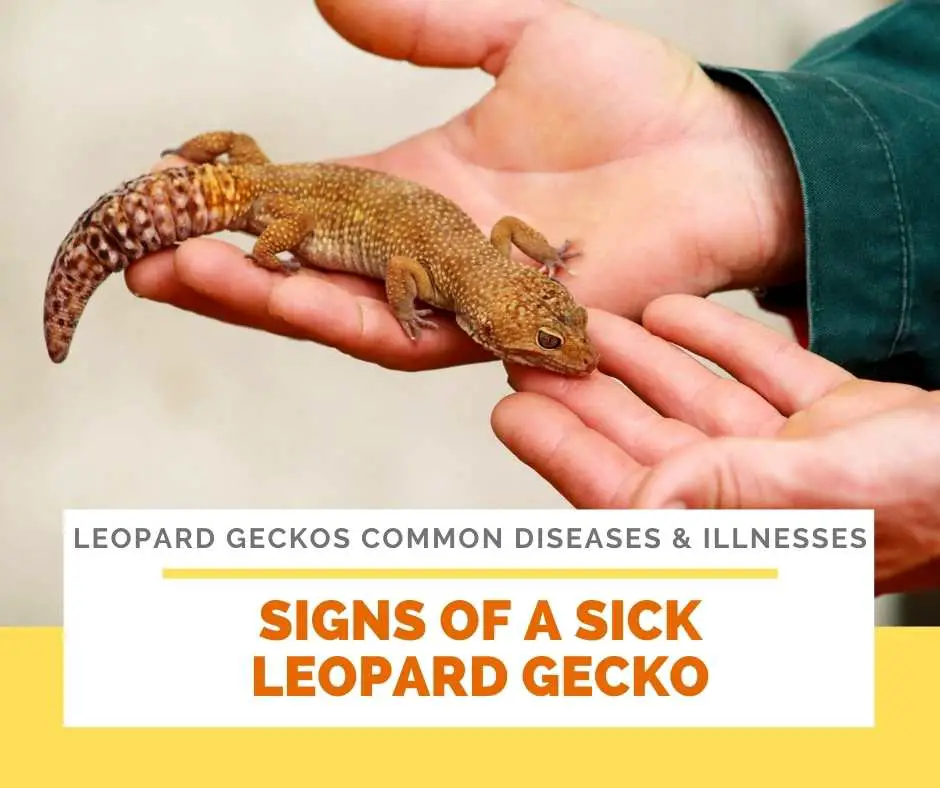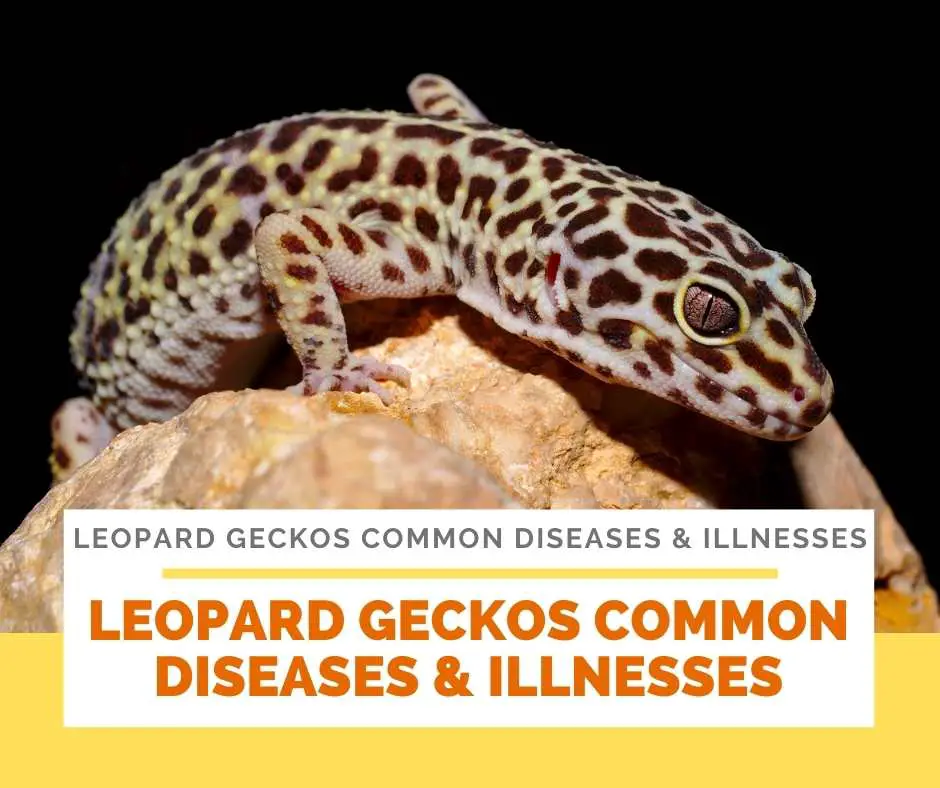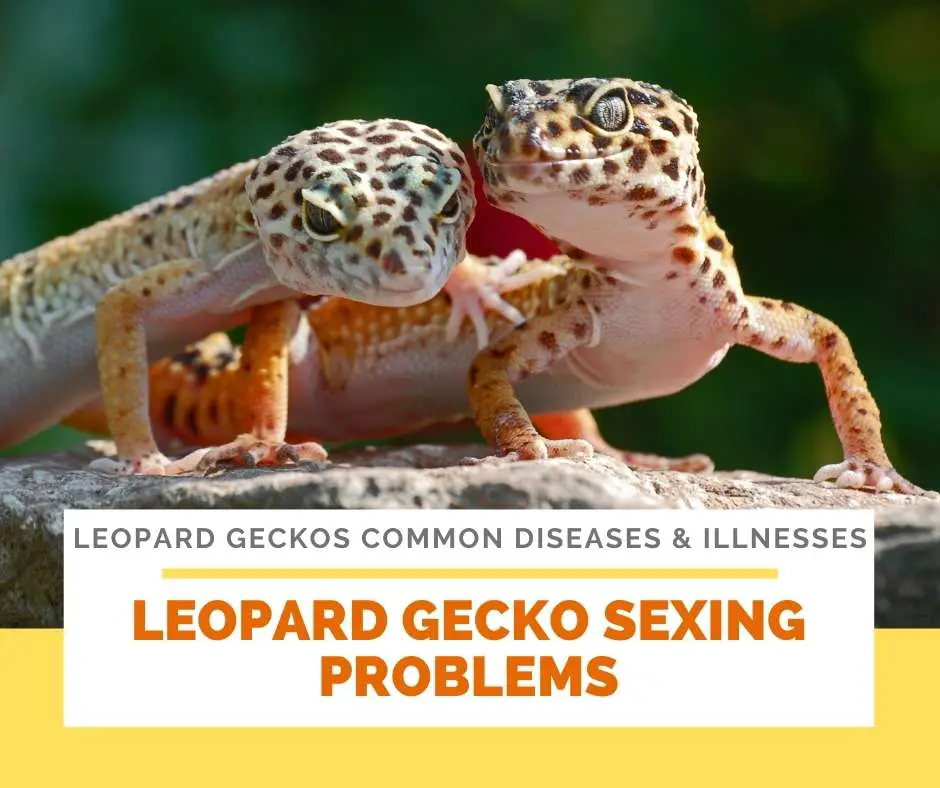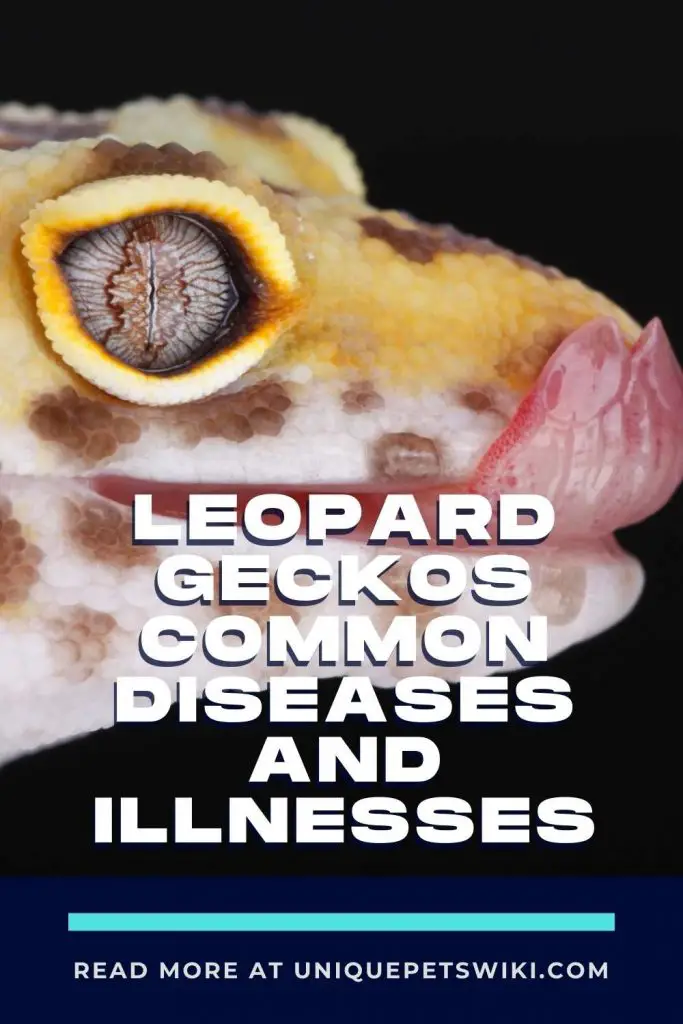It may be quite challenging to notice signs of illness in a leopard gecko. This is because many conditions are slow to develop and it may be difficult to easily spot them for beginner hobbyists.
However, you can spot that your leopard gecko is having a disease by always keeping an eye on their behavior.
Although leopard geckos are hardy creatures and can adapt to different conditions, they can become sick. Most of the time, leopard geckos get sick because of mistakes with their husbandry and care.
In this article, we will talk about the common leopard gecko diseases, their causes and treatments. You will also learn about the symptoms so you can easily diagnose your leopard gecko at home.
Contents
Signs Of A Healthy Leopard Gecko

A responsible gecko owner needs to check their leopard geckos every day for health issues. This helps to catch any disease early and prevent it from getting serious. Here are some signs of a healthy leopard gecko that you should be on the lookout for.
Body
The body of a healthy leopard gecko has a smooth outline with rounded sides. Although the ribs of your leo should not be protruding, your gecko should also not be obese.
Underbelly
A healthy leopard gecko should not have burns to the belly from heat pads. You will also not see any evidence of stools around the abdomen. A healthy leopard gecko should always be clean with no signs of injury in their underbelly.
Skin
A healthy leopard gecko should have bright and colorful skin unless it is shedding. The skin should also not be dirty or with cuts as it can make your gecko prone to infections and diseases.
Strength
Although leopard geckos are small in size, they are very strong for their size. When handling them, they should feel strong in your hand with a firm grip on your skin.
Tail
A healthy leo should have a fat tail unless they are hatchling and juvenile. You can easily use the changes in your gecko’s tail to determine how healthy is your gecko as it will be thinner if your gecko is not well.
Face
A healthy leopard gecko’s jaw is symmetrical and fits together with the body not jutting out or looking rubbery.
Eyes
Leopard gecko’s eye should be equal in size and it should not be bulging out of the eye socket or shrunk into the head. A healthy leopard gecko eye should have no dirt around them and should be very alert and bright eyed.
Feet And Toes
A healthy leopard gecko’s legs should be strong and come out underneath. Furthermore, their toes and feed should be clean and without stuck sheds around the toes.
Eating frequently
A healthy leopard gecko has a big appetite and will eat insects that wriggles in front of them. This makes it one of the easiest ways to determine if your leopard gecko is healthy.
A healthy leopard gecko will eat frequently and once your gecko stops eating, it may be suffering from an illness.
Poop
A healthy leopard gecko poop should consist of three parts and it should be soft but not runny. It should be dark in color, have a white yellowing excretion with little liquid pee. Leopard geckos preserve water by excreting urates in solid form.
Shedding
Like other reptiles, leopard geckos shed their skin on a regular basis. A healthy leopard gecko dead skin comes off in strips and pieces rather than in a large section. Furthermore, you will not find any old skin left on the body of a healthy gecko.
Young leopard geckos grow much faster than adult leopard geckos, this is why young gecko sheds their skin more often than adult leopard gecko.
Signs Of A Sick Leopard Gecko

Weight Loss
If your leopard gecko loses a lot of weight in a short time, it could be suffering from underlying health conditions and could lead to death. Some of the things that can cause weight loss are poor diet, poor husbandry, parasite infections, impaction, and so on.
The normal weight for adult male leo is between 60-90g while females are lighter about 45g. Once you notice that your gecko is losing weight, visit the vet immediately for diagnosis.
Furthermore, you need to ensure your gecko starts gaining weight again as they will not be able to fight off illness if they are losing weight
Lack Of Appetite
Lack of appetite and weight loss are closely linked when it comes to identifying that your leopard gecko is sick. Lack of appetite in leopard geckos can be an environmental issue or something more serious.
This is why you need to ensure the temperature and humidity in their enclosure is at optimal range to eliminate stress. However, if your leo is not eating after checking these things, you will need to contact your vet.
Abnormal Or No Droppings
One of the ways to determine if your leopard gecko is sick or dying is by checking their droppings or lack of droppings. If your leopard gecko experiences abnormal or few droppings, your gecko may be impacted.
Furthermore, if impaction is left untreated, it can lead to sudden deaths of your leopard gecko. Impaction occurs when your gecko swallows something that blocks their stomach which then causes digestive issues and other internal problems.
Sunken Eyes
If you notice that your gecko’s eyes are sunken into their face then it may be suffering from dehydration. Dehydration can cause several underlying health issues in leopard geckos and can cause lack of appetite and more sickness.
Some of the other dehydration signs that you can be on the lookout for are sticky mucus in the mouth and retained non-shedding skin.
Lethargy
A healthy lizard needs to be active, bright-eyed, and curious. However, if your leopard gecko is acting sluggish and stays in a place for hours, it may be sick. A sick leopard gecko may be too weak to lift themselves off their stomachs and this is why they stay in the same spot.
Leopard Geckos common Diseases & Illnesses

Metabolic Bone Disease (MBD)
Your gecko can develop calcium deficiency if there is not enough calcium in their food. This is why it is important to gut-load or dust feeder insects before feeding your gecko. Your gecko can also get calcium deficiency if you over supplement their food with phosphorus.
Some of the signs of MBD in leopard geckos are weakness, tiredness, lack of movement, and so on. Your gecko can also have problems catching prey when hunting for food. Another notable sign of MBD in leopard gecko is crooked legs.
If you notice that your gecko’s limbs look soft, weak, and have strong and round knees, then they may have MBD.
Once you notice that your gecko has MBD, it is best to start the treatment immediately. Offer your gecko with gut-loaded insects and dust it with calcium and vitamin D3 at all times.
However, if your gecko is at the last stages of the disease, you cannot reverse the changes and they will need injections to survive.
Impaction In Leopard Geckos
Leopard gecko are at a risk of gut impact if you are housing them on loose substrate. Baby leopard geckos are also likely to ingest substrates and a popular substrate is sand. This is because baby geckos are usually curious and may unintentionally ingest substrates.
Your gecko can also ingest substrates to get familiar with it if you change to another type of substrate or of different color. Your gecko can also get impacted if they ingest feeder insects that are bigger than their eyes length.
Some of the symptoms to help determine that your gecko is impacted are puffy stomach, lethargy, lack of appetite, and constipation. You will also feel the ingested material in their stomach when you feel it with your hand.
You can also take your gecko to the vet for an X-Ray to determine what your gecko has ingested. The best way to treat impacted leopard gecko is by giving your gecko with 3-4 drops of vegetable oil or petroleum jelly.
Furthermore, you can give your gecko a warm bath after giving the oil.
Respiratory Infection in Leopard Geckos
Leopard geckos can develop respiratory infection if you keep them in a bad terrarium setup. Your gecko can develop a respiratory infection if you keep them in a very cold or too humid enclosure.
Furthermore, this can also happen if you keep your gecko in an enclosure with substrates that crumbles too much.
Some of the symptoms of respiratory infection are hard breathing, wheezing, heavy breathing with an open mouth, gaping, and bubbles on the nose.
You can treat respiratory infection by increasing the temperature in the terrarium by 10 degrees Fahrenheit. You can also wash your gecko’s nose with warm chamomile tea solution.
However, you need to take your gecko to the vet if the symptom does not disappear within 5 days.
Egg Binding in Leopard Geckos
There are situations where female leopard geckos carrying eggs cannot lay their eggs and become egg-bound. Some of the things that can cause egg binding in leopard geckos are stated below.
- Your gecko has internal issues like tumors, broken pelvis, etc.
- Your leopard gecko is lacking calcium in her body. Calcium is an important nutrient for gravid leopard geckos as it helps in the formation of eggs and contraction of smooth muscle pushing the eggs in the oviducts.
- Your leo is not happy with the egg laying site or you did not provide a laying site for your gecko.
You can easily prevent egg binding in leopard geckos by ensuring your gut load and dust your gecko food with calcium daily and other minerals and multivitamins once a week. Furthermore, ensure you make a nesting site for your gecko around 10 days after mating.
You can easily detect that your gecko is gravid by placing a bright light close to her. However, you can take your gecko to a vet for an X-ray if you are not sure that it is gravid.
Note: leopard geckos can lay eggs without mating with a male but the egg will be infertile.
You will need to take your gecko to a vet to remove the eggs surgically or give your gecko some hormone or calcium injections if your gecko has egg binding disease.
Prolapse in Leopard Geckos Hemipenis
Leopard geckos’ hemipenis are the reproductive organs of male leopard gecko that comes out when mating, due to mechanical popping or impaction. However, there are times when the hemipenes can stay out and not go back inside naturally.
Once you notice this, you can try to push them back in or it can easily get inflamed and infected. If you did not notice blood, simply place your gecko on a wet towel and give your gecko a sugar bath 2 times a day.
However, if this does not work, then try to gently push it in with a cotton bud.
If it does not go back in after a few hours, you will need to see your vet. On your way to the vet, apply some Vaseline on the hemipenis to prevent inflammation.
Parasites Infestation
This is a health problem where a parasite lives inside of your geckos body. Furthermore, the parasites breeds, feeds, and grows in their body. However, leopard geckos can have parasites infestation in their body for months before you can notice that they are sick.
The best way that you can detect if your leopard gecko has parasite infestation is by taking a feces sample to the vet. It can then be treated by medicine that you give your gecko orally.
Burns
Leopard gecko can get burnt in their enclosure by heated pad, rock, or even light. This can turn to a serious problem for your leopard gecko and be fatal.
You can treat burns by taking your gecko to a vet where they give them some antibiotics or topical ointment on the scars.
However, the best cure for burns in leopard gecko is to prevent it by setting your gecko’s enclosure carefully.
Shedding Problems
Healthy leopard geckos regularly shed their skin and eat it in most cases. However, your leopard gecko can experience shedding problems. The signs of a shedding problem in leopard gecko is a stuck shed surrounding your gecko’s head, tail, toes and feet.
Stuck shed can make your gecko lose its toes and can be very painful, this is why you need to carefully remove them.
You can remove stuck shed by soaking or spraying the affected area with warm water to soften the shed. You can then peel it off gently afterwards.
The best way to prevent shedding problems in leopard gecko is by ensuring the humidity of your gecko’s terrarium is at optimum level. You can also place a humid hide box in their tank where your gecko can go when they are ready to shed the skins.
Leopard Gecko Pooping Problems
You don’t have to worry if your leopard gecko has not gone to the bathroom for a few days and it is behaving normally.
However, you might want to take action if it is five days or more and it is not pooping. Some of the reasons why your leopard gecko is not pooping are stated below.
Your leopard gecko is not eating enough
Your gecko will not be pooping regularly if it is not eating regularly. There are lots of reasons why your gecko will not eat, they are constipation, bullying, low tank temperatures, breeding, impaction, parasitic infections, etc.
If your gecko is not pooping because it is not eating regularly, then it is best to find out why it is not eating.
You Modified Their Terrarium
Leopard geckos are habitual organisms and prefer pooping at a particular location. However, if you modify their terrarium when cleaning or you add more accessories, your gecko may not poop.
It may take some days before they get used to their environment again and will find a spot to poop.
You can give your gecko a grace of one week to start pooping again. Furthermore, you can help your gecko by placing a paper towel that you use for cleaning up poop in the tank, so your gecko can smell his poop and easily find a spot.
The Tank Temperatures Are Too Low
Leopard geckos will not be able to digest food if their tank temperatures are too low. Low temperatures can lead to poor appetite and digestion which makes your gecko to stop eating. They will also find it difficult to excrete food that are not digesting properly.
You can prevent this by ensuring the temperatures in your gecko’s tank are at optimal level using digital thermometers to check the temperature daily.
Furthermore, fluctuations in leopard gecko’s tank can stress your leopard gecko and it is best to automate heating devices in their enclosure.
Your Leopard Gecko Is Dehydrated
Your leopard gecko is less likely to poop regularly if it is dehydrated. Water helps to keep your gecko’s digestive tract healthy and working smoothly.
Leopard geckos get most of their moisture from insects and you should ensure that you offer moisture to the feeder insects during the gut-loading process.
Some of the signs of dehydration in leopard geckos are folded skin and sunken eyes. Another way is by pinching their skin to check if it will go back to normal once you release it. However, if it stays in folding position, then your leopard gecko is dehydrated.
Although may leo do not drink from their bowl too often, you should ensure there is a water bowl in their tank with freshwater. You can also place a humid hide in their enclosure.
Your Leopard Gecko Is Impacted
When a leopard gecko gets impacted, it will not be able to poop. Leopard geckos can get impacted if they ingest loose substrate or insect feeder larger than their eyes. Impaction is more common in younger leos that are still exploring their environment.
There Is A Deadly Parasites In Your Leopard Gecko’s Guts
Your leopard gecko will refuse to eat if there is a parasite infestation. Your leopard gecko will then stop pooping because of lack of eating. Some of the signs of parasite infections are rapid weight loss or even runny stools.
Furthermore, once you suspect that your leopard gecko is affected by parasites, you should take it to the vet immediately.
Leopard Gecko Sexing Problems

Most geckos owners find it hard to differentiate between a male and female leopard gecko. You can easily sex a leopard gecko only if you know what you are looking for. You can easily sex your leopard gecko by checking the underside of your gecko.
It is quite hard to sex hatchling and juvenile leopard gecko. You will need to wait until around six months before you can sex your leo. Some of the key traits for identifying the sex of your leopard gecko are stated below.
Pre-anal Pores
Male leopard geckos have distinct V-shaped row of pre-anal pores in front of their vent. Once leopard geckos mature, the round pores that look like dots become more prominent while exuding a waxy material.
Although female gecko has a similar row of small pores, they are not that obvious.
Many hobbyists believe that female pre-anal pores are barely noticeable and they do not have waxy substance that is present in male leopard geckos.
Hemipenal Bulges
Male leopard geckos have two distinct bulges located behind their vent on both sides of their tail base. The hemipenis are the two penises located inside the sides of the tail and it comes out during breeding.
Some breeders use it to determine if a gecko is male by gently pushing these hemipenes out. However, this can cause prolapse of hemipenis or can cause injury to the hemipenis.
This is why it is best not to traumatize your gecko by trying this method. There are lots of less invasive ways that you can use to determine the sex of your gecko.
Femoral Pores
You can easily identify a male leopard gecko using the femoral pores. Males leopard gecko have enlarged pores on the underside of their hind legs on their thighs. Furthermore, they have straight line on each thigh that looks like pre-anal pores.
Baby Leopard Gecko Problems
Most of the new gecko owners don’t usually educate themselves about what a gecko needs in terms of housing or nutrition before bringing them home. This can lead to problems in the long-run.
In this section, we will talk about the common baby leopard gecko problems and what can cause it.
Metabolic Bone Disease
Baby leopard geckos especially those that are housed indoors without access to UV light can develop metabolic bone disease. This can also happen if the calcium to phosphorus ratio in the leopard gecko’s body is less than the ideal 2-1 ratio.
MBD will make their bones to never ossify and it stays soft and spongy and it can lead to fracture. If this continues, baby leopard geckos become weak and will stop moving and eating. It can also lead to the death of your gecko if you do not treat it immediately.
You should take your leopard geckos to the vet immediately if you notice that your gecko has MBD for treatment with calcium and vitamin D. If the disease is detected early, your leopard gecko can make a full recovery.
Impaction
Another common disease of baby leo is the gastrointestinal impaction. This health condition occurs when your gecko ingest loose substrates or big insects that obstruct their stomach.
When this happens, your gecko will stop eating, become weak, and can have problems with pooping. Once you notice that your leopard gecko is impacted, it is best to start treatment immediately as it can be life-threatening.
As stated above, the best way to treat impacted leopard gecko is by giving your gecko with 3-4 drops of vegetable oil or petroleum jelly. Furthermore, you can give your gecko a warm bath after giving the oil.
Shedding Problems
Baby leopard gecko sheds regularly and there are situations where your gecko can have problems shedding their skin. The major cause of shedding problems in baby leopard gecko is the lack of humidity.
If you keep your gecko in an enclosure with low humidity, it gets dehydrated and there will be retained patches of skin around their toes and eyes.
Stuck shedding causes constriction of blood circulation which can cause loss of digits. It can also interfere with their vision.
Baby leo suffering from stuck shedding can lead to loss of weight, eating problems, and even death.
The best way to help your gecko is by ensuring the humidity in their enclosure is at optimum level, helping your gecko to remove stuck skins, and to hand feed your gecko until it can eat on its own.
Leopard Gecko Health Concerns
Here are some of the health concerns about leopard geckos that you should be worrying about.
- Tail dropping
- Stress
- Lethargy
- Lack of Appetite
- Soft bones
- Tail thinning
- Problems catching prey when hunting
Do Leopard Gecko Die of Old Age?
Yes, leopard geckos can die of old age. However, Leopard geckos have a long lifespan and can live for 10-20 years. They can also live for more than 20 years if you can care for them very well.
Furthermore, the male leopard geckos tend to live longer than female leos.
Conclusion

Although leopard geckos are hardy creatures, there are several health concerns that can happen to them. However, you need to always keep an eye on your gecko so you can easily detect any health concerns very early.
